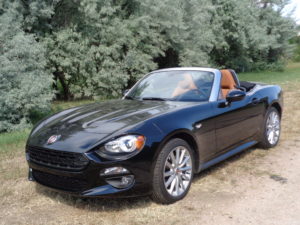
Beautiful and quiet it was one morning recently along Colo. 14 in Poudre Canyon; the rafters on the river appeared in greater numbers than the motorists.
The lack of highway traffic added to the appeal of testing the slick-looking 2016 Infiniti QX60 all-wheel-drive luxury midsize crossover.
The QX60 is Infiniti’s best-selling model and for 2016 has undergone improvements in its suspension and steering. It seems a worthy competitor to the Acura MDX, Audi Q7 and even the Lexus RX350.
Jan, observing a wedding anniversary with me that day, commented on the nice ride after only a few miles into the canyon; the QX60’s stability was also effectively tightened with the new, updated shocks and springs.
The Infiniti is a good handler. A new electronic power steering system is tuned for more instant response to driver input at the wheel.
Performance is just average from the SUV’s 3.5-liter V-6 with 265 horsepower and 248 lb.-ft. of torque, and its continuously variable transmission. A rotary-dial drive-mode selector gives the operator a choice of four modes – Standard, Sport, Eco and Snow.
A chance to sit on the river’s-edge patio and watch the rafters float by lured us to the Mishawaka restaurant for lunch.
On the road again, we drove up the canyon as far as the old Sportsman’s Lodge, then turned back.
When I turned onto the Stove Prairie Road, heading for Masonville, the day became one of excellence for an automotive reviewer. With the narrow road and its twists and dips and ups and downs at hand, I moved the Infiniti’s shifter into manual mode, bypassing the CVT.
I drove the next 15 miles in 2nd and 3rd gears, only occasionally easing into 4th. This lends tight control of the QX on the cornering and climbing, with little need for braking.
Our entire drive that day covered 160 miles and the Infiniti averaged 22.1 miles per gallon. Its overall average for the week was 20.5. That is low, for its EPA estimate is 19/26.
The Infiniti offers three rows of seating. Of the little cargo space behind the third row of seats, a portion of it is grabbed by a subwoofer for the easy-listening sound of the Bose Acoustic Wave system with 14 speakers.
Adding to the smooth-looking exterior of the QX60 are a bold mesh grille and wraparound headlights. Stylish wheels adorn the Bridgestone Dueler 235/55R20 tires.
The QX60 AWD’s base price is a competitive $44,400, but an inordinately long list of optional equipment pushes the sticker total to a pricey $59,345.
Among the add-ons are pearl paint for $500, a technology package including second and third-row moonroof with power sunshade and heated second-row seats, the theater entertainment package, premium-plus package with navigation 8-inch touchscreen display and around-view monitor, and premium option with heated steering wheel and remote engine start.
All the products for Infiniti, Japanese luxury car builder for Nissan, became identified by new nomenclature a couple of years ago.
The Q50 four-door models are formerly those with G37 identification. Q60s are coupes and convertibles, Q70s are the former M37s. SUVs and crossovers carry QX designations. The former EX37 is now QX50, the JX35 is the QX60, the FX37 and FX50 are QX70s and the full-size SUV, the QX56, is the QX80. Infiniti said its lineup, with the Q and QX designations, is more easily identified by the public.


